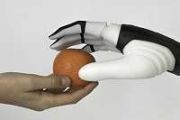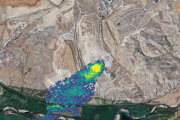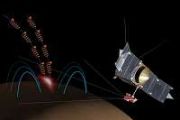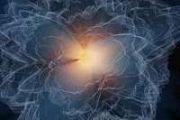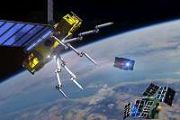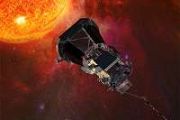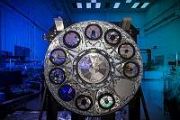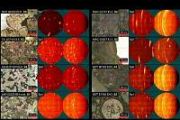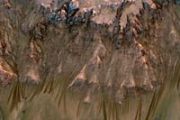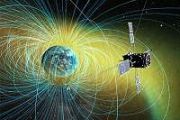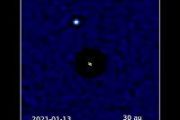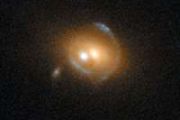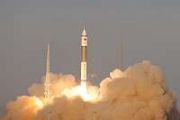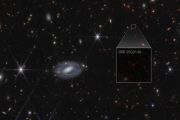
Copernical Team
Ensuring the accuracy of ESA’s FORUM climate mission

The European Space Agency’s upcoming FORUM mission is set to provide unique insights into Earth’s radiation budget, filling in a missing piece in the climate puzzle. The mission’s spectrometer will be the first space-based instrument to measure Earth’s outgoing radiation in the far-infrared part of the electromagnetic spectrum with unprecedented resolution and accuracy. New technologies were needed to make this possible – among these an on-ground calibration device developed by the National Metrology Institute of Germany PTB within a recent activity funded by ESA’s General Support Technology Programme. This device is used
Water signature detected in interstellar comet 3I ATLAS
 A fragment of ancient ice and dust from another star system has arrived in our cosmic neighborhood as 3I/ATLAS, only the third interstellar comet ever found. Using NASA's Neil Gehrels Swift Observatory, Auburn University physicists detected hydroxyl gas, the ultraviolet by-product of water, confirming active water release from this visitor.
Swift's vantage point above Earth's atmosphere en
A fragment of ancient ice and dust from another star system has arrived in our cosmic neighborhood as 3I/ATLAS, only the third interstellar comet ever found. Using NASA's Neil Gehrels Swift Observatory, Auburn University physicists detected hydroxyl gas, the ultraviolet by-product of water, confirming active water release from this visitor.
Swift's vantage point above Earth's atmosphere en General purpose AI classifies transient cosmic events from just a few examples
 A study co-led by the University of Oxford, Google Cloud and Radboud University shows a general-purpose large language model, Google's Gemini, can identify real celestial changes and explain its reasoning using only 15 example image triplets and brief instructions, achieving about 93% accuracy across ATLAS, MeerLICHT and Pan-STARRS alerts.
The workflow ingests New, Reference and Difference
A study co-led by the University of Oxford, Google Cloud and Radboud University shows a general-purpose large language model, Google's Gemini, can identify real celestial changes and explain its reasoning using only 15 example image triplets and brief instructions, achieving about 93% accuracy across ATLAS, MeerLICHT and Pan-STARRS alerts.
The workflow ingests New, Reference and Difference Webb reveals carbon rich disc around giant exoplanet
 NASA's James Webb Space Telescope has captured the first detailed measurements of a circumplanetary disc that may serve as a birthplace for moons around a massive exoplanet. The discovery, involving the companion world CT Cha b located 625 light years away, sheds light on how Jupiter's Galilean satellites may have emerged more than four billion years ago.
The international team used Webb's
NASA's James Webb Space Telescope has captured the first detailed measurements of a circumplanetary disc that may serve as a birthplace for moons around a massive exoplanet. The discovery, involving the companion world CT Cha b located 625 light years away, sheds light on how Jupiter's Galilean satellites may have emerged more than four billion years ago.
The international team used Webb's Computer models point to crew diversity as key to resilient Mars missions
 Simulation results from Stevens Institute of Technology researchers Iser Pena and Hao Chen indicate that who you send to Mars matters as much as what you send. Published October 8, 2025 in PLOS One, the study used agent-based modeling to probe how personality mix and team roles shape stress, health, performance, and cohesion over a simulated 500-day mission.
The model linked individual dif
Simulation results from Stevens Institute of Technology researchers Iser Pena and Hao Chen indicate that who you send to Mars matters as much as what you send. Published October 8, 2025 in PLOS One, the study used agent-based modeling to probe how personality mix and team roles shape stress, health, performance, and cohesion over a simulated 500-day mission.
The model linked individual dif University of Mississippi Law School launches first fully online Air and Space Law master's degree
 The University of Mississippi School of Law has introduced the nation's first fully online Master of Science in Air and Space Law, designed to equip professionals for leadership roles in the fast-growing aerospace sector. Created in collaboration with instructional design firm iDesign, the program delivers a comprehensive legal foundation for those working in aviation, commercial space, and emer
The University of Mississippi School of Law has introduced the nation's first fully online Master of Science in Air and Space Law, designed to equip professionals for leadership roles in the fast-growing aerospace sector. Created in collaboration with instructional design firm iDesign, the program delivers a comprehensive legal foundation for those working in aviation, commercial space, and emer Trump jeopardising US role as scientific leader: Nobel officials
 Donald Trump's assault on science could threaten the United States' position as the world's leading research nation and have knock-on effects worldwide, Nobel Prize officials in Sweden told AFP.
Since taking office in January, the US president has cut billions of dollars in funding, attacked universities' academic freedoms and overseen mass layoffs of scientists across federal agencies.
Donald Trump's assault on science could threaten the United States' position as the world's leading research nation and have knock-on effects worldwide, Nobel Prize officials in Sweden told AFP.
Since taking office in January, the US president has cut billions of dollars in funding, attacked universities' academic freedoms and overseen mass layoffs of scientists across federal agencies. Rocket Lab widens iQPS partnership with three more dedicated Electron launches starting 2026
 Rocket Lab has signed a new multi-launch agreement with Japan's Institute for Q-shu Pioneers of Space (iQPS), adding three dedicated Electron missions from Launch Complex 1 in New Zealand beginning no earlier than 2026 and making Rocket Lab the primary launch provider for the QPS-SAR constellation.
The additional flights lift iQPS's upcoming Electron manifest to seven, on top of four alrea
Rocket Lab has signed a new multi-launch agreement with Japan's Institute for Q-shu Pioneers of Space (iQPS), adding three dedicated Electron missions from Launch Complex 1 in New Zealand beginning no earlier than 2026 and making Rocket Lab the primary launch provider for the QPS-SAR constellation.
The additional flights lift iQPS's upcoming Electron manifest to seven, on top of four alrea Raytheon and Anduril achieve breakthrough test in advanced rocket propulsion
 Raytheon, an RTX business, and Anduril Industries have completed a successful static fire test of an advanced solid rocket motor under contract with the U.S. Air Force Research Laboratory's Munitions Directorate. The achievement marks a major step toward expanding U.S. rocket motor production and strengthening the defense industrial base.
With global demand for munitions rising, the test u
Raytheon, an RTX business, and Anduril Industries have completed a successful static fire test of an advanced solid rocket motor under contract with the U.S. Air Force Research Laboratory's Munitions Directorate. The achievement marks a major step toward expanding U.S. rocket motor production and strengthening the defense industrial base.
With global demand for munitions rising, the test u DLR's ATHEAt Flight Experiment Achieves Hypersonic Milestone Over Norway
 The German Aerospace Center (DLR) has successfully launched its ATHEAt flight experiment from Andoya, Norway, marking a major advance in reusable space transportation technology. The sounding rocket lifted off on 6 October 2025 at 10:45 local time, flying for approximately four minutes and surpassing Mach 9 for two of those minutes - conditions comparable to atmospheric re-entry.
During th
The German Aerospace Center (DLR) has successfully launched its ATHEAt flight experiment from Andoya, Norway, marking a major advance in reusable space transportation technology. The sounding rocket lifted off on 6 October 2025 at 10:45 local time, flying for approximately four minutes and surpassing Mach 9 for two of those minutes - conditions comparable to atmospheric re-entry.
During th 








